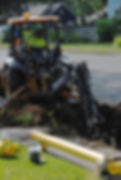- Nora Koch
- Jul 15
- 2 min read

A couple weeks ago Peter came in to tell me some bad news: A guy stopped him outside to tell him utilities were being upgraded in our neighborhood and the city would need to dig up a garden on the corner boulevard.
So Peter dug up a bunch of the plants and we’ve been watering them. They will survive and we will plant them back.
This has been my most successful garden. I’ve had children thank me for it (I was astounded and so pleased). I knew when I planted it, it was on city land and only two years ago transplanted some of the thriving Prairie Smoke onto another part of our yard because I was afraid something such as this might happen.
Yes, yet another bunch of white supremacists are out there on what was once my garden. But I feel comfort from the guys on a 90+ ˚ day who are doing hard jobs, with skill - look at the relaxed pose of the guy in the back hoe. They did some of the work a week ago and gallantly even dug up a Vervain plant I’d put in last year (that I’d dug up from a ditch). I thought it was safe, but they are thorough in their destruction and this one was right in the path of it. They were good natured, kind and wary of me, probably thinking I was going to start nagging them about how awful they are.
Rather than being annoyed by them during prayer time this morning (and I’m not saying this to point out how virtuous I am), I found the sound of them talking, calling out to each other, and making noise from working comforting, the same way I find sirens comforting. Men are taking care of things that need to be taken care of. I’m glad they are there.
The history of this garden: I started it by throwing some pink spiraea that I was trying to get rid of, but didn’t have the heart to outright kill into the corner boulevard. After that I threw in a a bunch of sage I’d weeded out of other gardens. I planted what I thought was little blue stem, which turned out to be big bluestem and regretted it. I transplanted echinacea from another part of the yard where it was being overshaded by growing trees, and threw in some seeds from the same. I was most deliberate in planting, and most concerned about losing Russian Sage I’d bought from the Anderson Greenhouse after Lori’s husband suddenly and unexpectedly passed away, and Prairie Smoke from a ditch by Osseo, Wisconsin that I’d dug up with my now deceased Mother. After planting both plants in different parts of our yard where they barely managed to stay alive, I transplanted them to the boulevard, probably ten years ago. None of this was carefully thought out. Everything thrived in the harsh conditions: constant sun, summer and winter, little rain during drought years, being hit by snowplows and scattered with salt.
Now it is a big hole in the ground.
I think the big bluestem problem is solved.





